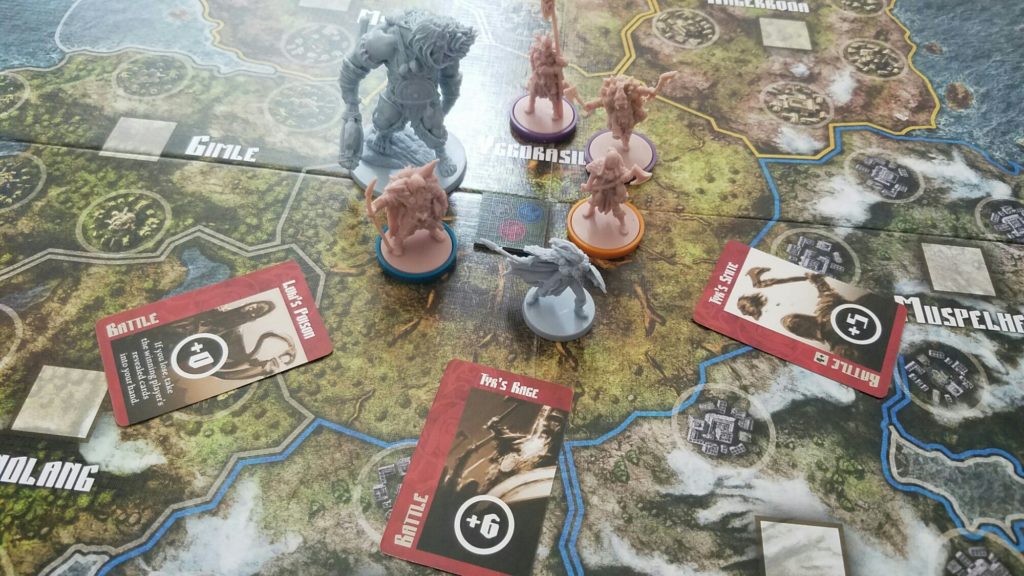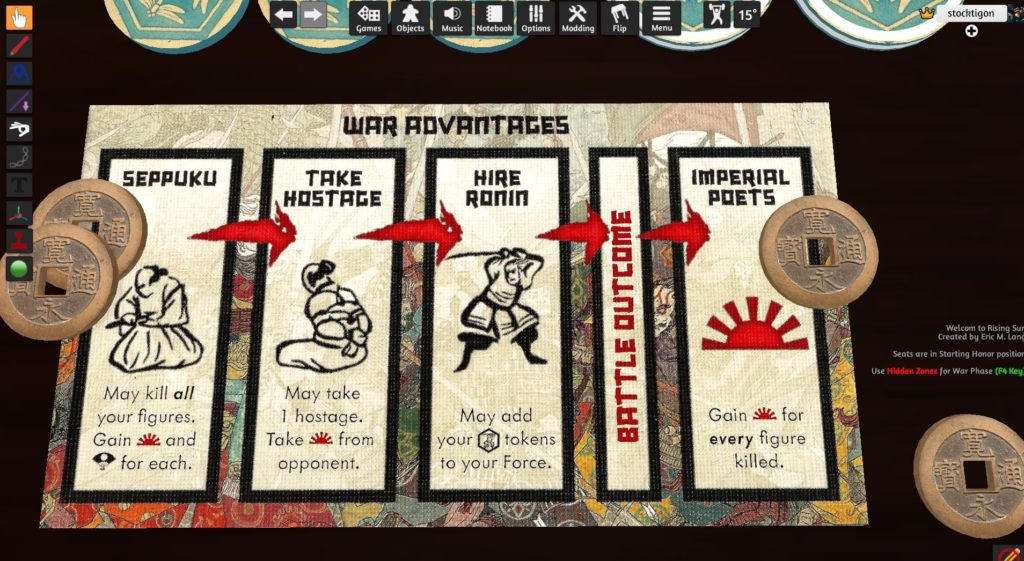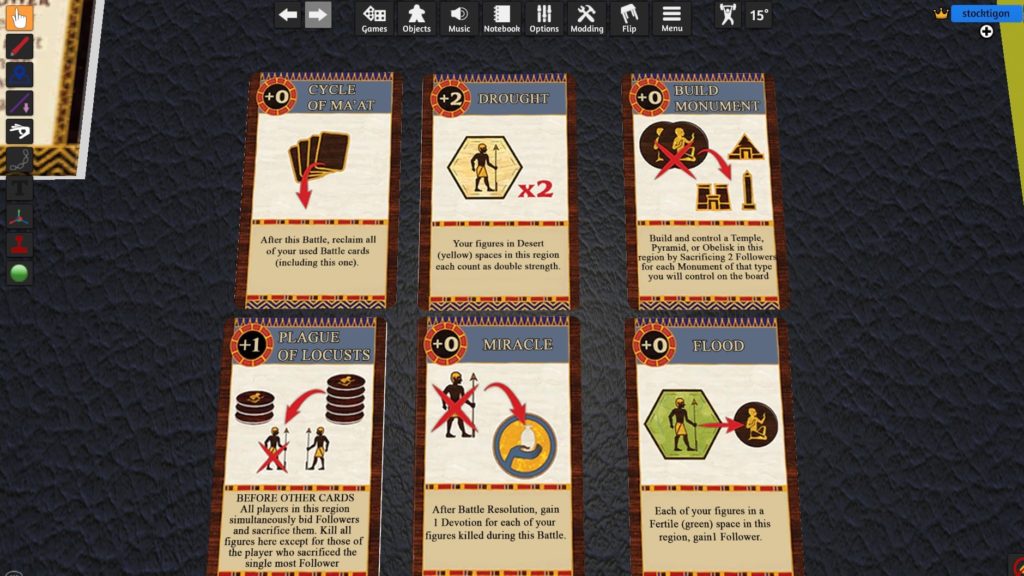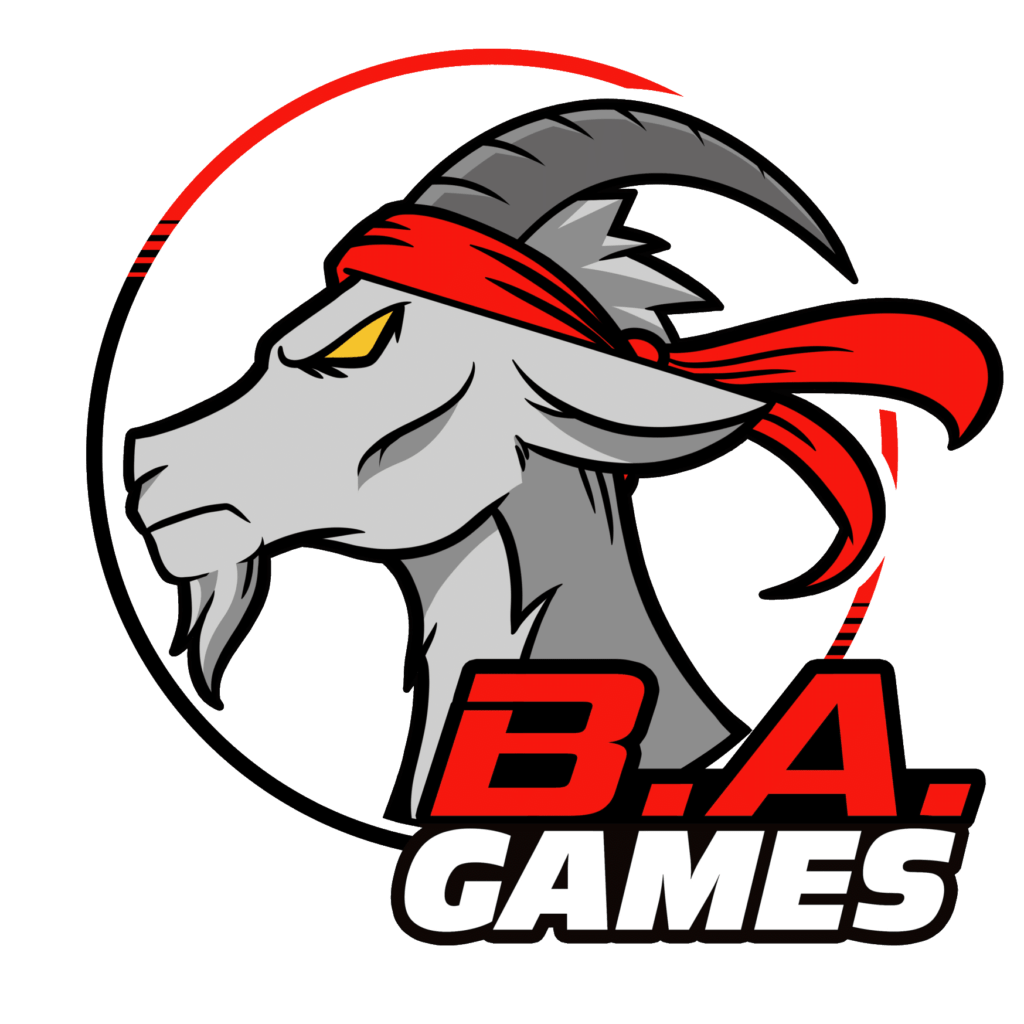Case Study of Blood Rage, Rising Sun, and Ankh – Part 2 (Combat Systems)
Sam “King of the Hilltop”
Today we talk part 2 of this case study series covering Eric M. Lang’s Legendary Saga series of board games. If you missed part 1, you can check it out here.
In area control games, conflict is inevitable as you seek to control the different areas of the board. Some are more constant, while others tend to minimize conflicts as much as possible. Let’s take a look on how these 3 games stack up.
Blood Rage
Blood Rage incorporates its combat in two parts of the game. The first part being the cards that you draft at the beginning of each epoch or round are the cards you will be using for combat. When a combat occurs, you will tally each player’s force in the area and then each player places a card face down. Once all cards are placed, they are revealed, adding their force to the combat and also providing any special abilities on top of that.

The second part of the combat system for Blood Rage is the fact that combat can be triggered as an action called pillage. It’s a free action that starts a fight if there are any opponents in the area. It also then allows people to move miniatures from places next to the area and bring them in for a fight. If you start the pillage and win, you will then be given the resource development for that region which makes your clan stronger.
Thoughts
This whole design pushes people to fight. Now the combat cards will change your strategy of how you fight, meaning you may actually want to lose in order to gain bucket loads of glory points (victory points), but fighting is the mechanism by which that happens. It provides a constant flow of combat and it rewards you for being the aggressor. There are a couple of issues that can occur in the late game with a turtling strategy but that is not the dominant design and this design is BRUTAL!
There is a heavy load of knowledge though that is required to be the most effective at combat. You will need to know what cards are out there and available to the other players. This is reduced somewhat by having the draft occur 3 different times during the course of the game but you still need to know what is out there in order to effectively use combat to your advantage.
Final Thought
Very fun, constant action, picking fights. Drafting and mind games make for fairly quick but very interesting combat experiences.
Rising Sun
Rising Sun takes a different approach from Blood Rage in that combat only occurs at the end of a round. There will be a lot of movement, negotiation, and various small political conflicts before you get to the final part of the round with actual combat.

This is where Rising Sun does something very interesting; it uses bidding to influence combats and their outcomes. Whoever has the most force in an area after combat only guarantees 1 thing – you don’t lose all of your miniatures in that area. That’s it. Everything else is up for grabs. You can seppuku your miniatures in order to gain victory points and increase your spot on the honor track (which is used for tiebreaking). You can literally kidnap a miniature to steal a victory point from an opponent. You can add additional force by hiring Ronin which happens throughout the round. Then, once it is all said and done, you bid on who gets the victory points for that combat.
Then after all losing players discard their money used, the winner who holds the area then splits their money and divvies it out to the losing factions.
Thoughts
The game forces you to think on a larger scale. You can’t just be combat focused. You have to worry about what other people are doing and how they are trying to win. How they are going to turn a losing situation into a winning one. Then because of the “war reparations” that occur after combats, you have to worry about what your other combats are doing and are you just helping the enemy instead. It’s a game of shifting priorities and a game where you need to know what result you want to have at the end of it all.
The way bidding works just throws traditional conflict on its head and gives you a lot to think about. It’s a thinking man’s war game in that you have to concern yourself with your end goal and not just the individual combats you are in.
Also, the fact that combat only occurs at the end of a round after all the political and negotiating happens, puts more emphasis on the combat round. There is more of a build-up instead of a constant fight for your life.
Final Thoughts
When I first played Rising Sun, I hated it. Going to be honest. It was not what I expected. I was looking forward to rip-roaring combat and destruction and instead I was hit by political intrigue, resource management with bidding, and the feeling that even if I won combat, it meant nothing unless I also paid for it. It was a nasty first shock for me.
However, after some more plays I have actually warmed up to the combat quite a bit. When people talk about Rising Sun, I find that this is their favorite part. It is combat, resource management, bluffing, and strategic thinking all wrapped into one. The combats can be very satisfying but can take a bit to wrap your head around as there are a number of consequences, even unforeseen ones, that can happen.
Ankh
Ankh is the 3rd game in the series and honestly, it feels like a hybrid, and it does it well. The combats don’t occur until after a few rounds of playing actions as you move the event track markers. So again, like Rising Sun, combats are not as frequent but there is an emphasis on those conflicts as you build up to them.
When combat starts, you tally your current force total versus your opponents and then each player is going to play a card face down. This is very reminiscent of Blood Rage. However, in this case, you have a limited choice of cards that you can play from your hand and everyone has the same cards. This can lead to the mind games you see in Rising Sun but using a simpler mechanic like in Blood Rage.

These cards will do different things and some are focused on force but others allow to gain followers, which is a currency in the game that allows you avoid/cause plagues, or build monuments to your name.
However, once a card is played, it is unavailable to you unless you play a Cycle of Ma’at card which allows you to get your cards back. So, you need to be careful and prioritize again what you want from a fight. Another resemblance between Rising Sun and Ankh.
Then after combat, there is devotion gained from winning (victory points) but there is also devotion scored from having the most monuments in an area of a given type like: Obelisk, Pyramid, and Temple. So even losing combat does not mean you necessarily don’t gain anything. However, not having miniatures in a region means you will likely not score those devotion points so you need to make sure you are able to do so, or just have your god there since they are invulnerable. But then they are not helping the other regions to win – choices, choices.
Thoughts
Having a build up can lead to some interesting decisions and makes you focus on those impending conflicts. The card bluffing is very manageable after playing a game of Ankh and doesn’t require the depth of knowledge you would need in Blood Rage.
Final Thoughts
I really enjoyed Ankh’s combat system as it plays rather quickly. Though I am personally a big fan of constant combat like you would get in Blood Rage. Ankh is an interesting hybrid that definitely shows the evolution and thoughts Eric M. Lang had about the different games. His decisions made Ankh a shorter more focused board game compared to the others but I am still curious how things shake out when they finalize the game. They are very close, which is why I felt confident in doing a case study on these games, but Ankh is my personal favorite. It balances the game in that focusing on winning conflicts is a legitimate way to win the game. You don’t have to and there are other ways to win, like monument building to build up your devotion more passively or developing overwhelming economic power to crush people with plagues.
Conclusion
Each of these games offers a unique take on combat but it is interesting to see the similarities as well as the differences. The key factor that I see is that winning a battle should not be the only path to victory. Eric M. Lang seems to preach this from the pulpit and it was a foreign concept to me at first coming from a heavy wargame and tabletop miniature background. However, I think this explains his appeal to a number of board gamers.
People want that conflict but they also want different ways to win. They want freedom to make choices and then feel rewarded for those choices. These games provide that in different ways and honestly are something you should check out if you are interested in designing combat focused area control games.
The Duke’s Quick and Brief Thoughts On Rising Sun Combat Mechanics
Ed “Duke of BAzlandia”
I had the pleasure of playing Rising Sun for the first time during a family reunion a little over two years ago. My brother Dave was visiting a game store before the reunion and over the phone I had him list games he could see on the shelf. As he ran down the list we came upon Rising Sun (the store happened to have a Kickstarter package of it) and I had him buy it and bring it to the reunion that was happening later that week.
At the Family Reunion we played several times throughout that weekend. The game was quite good and I thoroughly enjoyed the alliance and negotiation aspect and how important it was to have an alliance. Needless to say, much to my detriment, I often found myself without allies during the several play throughs due to my reputation among my brothers for being “nefarious” and “treacherous” and always having ulterior motives that only benefit me (like they don’t have the same reasons for alliances).
This is when I discovered that for what looks and feels like a war game combat isn’t just about taking territory. I had played several “war” games before where combat wasn’t solely about gaining territory. Even when going into a game where I know this, it still surprises me. I am not sure why but maybe it’s because as a child I played too much Risk, but regardless I enjoyed the combat in this game.
One of the things I enjoyed most about the combat system is the known and unknown portions of the combat flow. You go into battle knowing an enemy’s potential strength which is represented by figures and coins but what is not known is how your enemy plans on using these on the different war actions available or if they plan on using any at all. At the beginning of the combat a player assigns coin(s) to different war actions behind a screen. In some ways this simulates the fog of war and the unknowns of how your enemy is arraying their forces for battle. These war actions effect the eventual outcome of the battle. At the conclusion of the battle, the player with the most strength wins the battle. That’s when the war action of Imperial Poets comes into play and awards victory points based on the number of figures lost in the battle. These victory points are awarded to the player who wins Imperial Poet and not the player who wins the battle or the player who has the greatest strength. A losing player can actually gain more out of losing then by winning. Another interesting mechanic is the losing player(s) discards all of their coins, the winning player gathers their spent coins and gives them as war reparations to the losing player(s).
In the end I really enjoyed the “combat” of Rising Sun. It allows for some very strategic choices and really brings into play the idea that you can lose the battle but win the war, or in this case, win the game.
